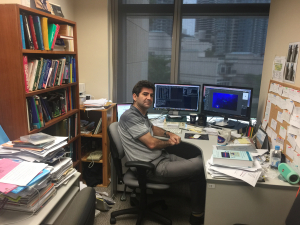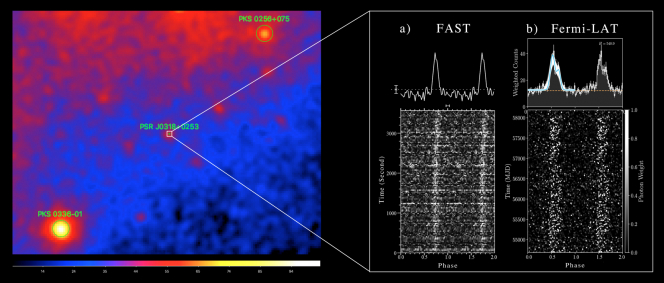Media
HKU Laboratory for Space Research involved in international collaboration facilitates the discovery of an isolated Millisecond Pulsar with FAST
06 May 2018
An International team led by the Chinese Academy of Sciences with scientists from the Mainland, United States and the Laboratory for Space Research of the University of Hong Kong (HKU) has discovered an isolated Millisecond Pulsar (MSP) using the Five-hundred-meter Aperture Spherical Telescope (FAST), the first of its kind discovered with FAST.
The new pulsar, named PSR J0318+0253 after the coordinates of its location in the sky, is an isolated MSP with a spin period of 5.2 ms and an age of approximately 5 billion years, with an estimated distance of about 4,000 light-years.
FAST, nicknamed Tianyan or literally "Heavenly Eye" in Chinese, is the largest single dish radio telescope in the world. It achieved first light in September 2016. Although still under commissioning, FAST has already started taking data and is the most sensitive radio telescope for pulsar searches.
FAST earlier signed a Memorandum of Understanding (MOU) with Fermi (Large Area Telescope of the Fermi Gamma-ray Space Telescope, also known as Fermi-LAT) of the US by virtue of which FAST astronomers have started collaborating with Fermi LAT team members.

Dr Pablo Saz Parkinson of HKU Physics Department and Laboratory for Space Research applying sophisticated machine learning techniques to produce a ranked list of predicted pulsars for FAST to work on
Dr Pablo Saz Parkinson, member of the HKU Physics Department and Laboratory for Space Research (LSR) and signer of the Fermi-FAST MOU has been applying sophisticated machine learning techniques to Fermi catalogs. Upon the release of the most recent Fermi source list, Dr Saz Parkinson's team produced a ranked list of predicted pulsars among the unassociated gamma-ray sources. Among those sources is the newly-discovered MSP, presumably the first of many to come out of this Fermi-FAST collaboration.
“Finding millisecond pulsars is extremely challenging. In addition to the computational challenges associated with their fast periodicities, millisecond pulsars are distributed isotropically in the sky, unlike "standard" pulsars that are mostly located along the Galactic Plane. It is exciting to see the results of our new collaboration between Fermi and FAST bear fruits so quickly; hopefully it is a sign of the many more results to come,” said Dr Saz Parkinson.
“The detection of a millisecond pulsar by the new Chinese FAST, the world's largest single dish radio telescope, is only the first what I am sure will be many such exciting discoveries. I am looking forward to members of the HKU astrophysics community gaining access to this wonderful new facility in the Mainland,” echoed Professor Quentin Parker, Director of the HKU Laboratory for Space Research.
Pulsars are rapidly-spinning neutron stars, formed when a massive star explodes at the end of its life. The first pulsar was discovered in 1967 and approximately 2,500 pulsars are now known. Most pulsars have spin periods of tens of milliseconds to tens of seconds, but some pulsars, the so-called millisecond pulsars, have periods of 1-10 ms. These pulsars, much older than standard pulsars, are thought to be born after young pulsars in binary systems have been "spun" up (or "recycled") through the transfer of angular momentum from their companion. The first millisecond pulsar was discovered in 1982 and only approximately 10% of all known pulsars are MSPs (around 250 pulsars).
In addition to being extremely interesting astrophysical objects, MSPs, due to their mush faster spin periods, as well as their much greater stability, are among the most useful tools in Physics. Indeed, their use in confirming General Relativity resulted in the 1993 Physics Nobel Prize. Future uses of MSPs include the detection of gravitational waves. A large international effort, known as the International Pulsar Timing Array (IPTA) has been organized for this purpose to carry out the precise timing of a collection of MSPs with various radio telescopes around the globe. Given the properties of the new FAST MSP, the new pulsar is likely to be among those used for this purpose.

The Gamma-ray sky map and integrated pulse profiles of the new MSP: Left panel shows the region of the gamma-ray sky where the new MSP is located. Right panel a) shows the observed radio pulses in a one-hour tracking observation of FAST. Lower panel b) shows the folded pulses from more than 9 years of Fermi-LAT gamma-ray data
Image download and illustration: http://www.scifac.hku.hk/news/media?page=1
For media enquiries, please contact Ms Cindy Chan, Senior Communication Manager of HKU Faculty of Science (tel: 3917 5286/ 6703 0212; email: cindycst@hku.hk) or Dr Saz Parkinson at pablosp@hku.hk

